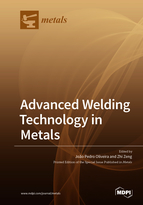Advanced Welding Technology in Metals
A special issue of Metals (ISSN 2075-4701). This special issue belongs to the section "Metal Casting, Forming and Heat Treatment".
Deadline for manuscript submissions: closed (31 December 2020) | Viewed by 86772
Special Issue Editors
Interests: advanced characterization; martensitic transformation; thermomechanical processing; welding; synchrotron radiation; additive manufacturing
Special Issues, Collections and Topics in MDPI journals
Interests: laser welding; shape memory alloys; numerical modeling; stress and distortion; fatigue
Special Issues, Collections and Topics in MDPI journals
Special Issue Information
Dear Colleagues,
Welding and joining technologies are fundamental in advanced engineering alloys to expand their applications. At present, we often observe significant developments in the areas of welding and joining, with more complex and sophisticated variants available. Another key area of interest is related to welding metallurgy: The microstructural changes induced by welding and joining techniques can drastically modify the joints mechanical behavior. For that reason, it is necessary to correlate process parameters, microstructure, and mechanical response in welded joints. Finally, simulation and modelling of the thermomechanical behavior during welding and the predictions of existing phases due to the weld thermal cycle are critical to optimize welding parameters.
For this Special Issue, we invite our colleagues to submit papers in the areas of welding and joining. The topics of interest include but are not limited to similar and dissimilar joining, fusion and solid-state processes, modeling and simulation, process development, and advanced characterization. Review papers and short communications are also of interest to this Special Issue.
Prof. Dr. João Pedro Oliveira
Prof. Dr. Zhi Zeng
Guest Editors
Manuscript Submission Information
Manuscripts should be submitted online at www.mdpi.com by registering and logging in to this website. Once you are registered, click here to go to the submission form. Manuscripts can be submitted until the deadline. All submissions that pass pre-check are peer-reviewed. Accepted papers will be published continuously in the journal (as soon as accepted) and will be listed together on the special issue website. Research articles, review articles as well as short communications are invited. For planned papers, a title and short abstract (about 100 words) can be sent to the Editorial Office for announcement on this website.
Submitted manuscripts should not have been published previously, nor be under consideration for publication elsewhere (except conference proceedings papers). All manuscripts are thoroughly refereed through a single-blind peer-review process. A guide for authors and other relevant information for submission of manuscripts is available on the Instructions for Authors page. Metals is an international peer-reviewed open access monthly journal published by MDPI.
Please visit the Instructions for Authors page before submitting a manuscript. The Article Processing Charge (APC) for publication in this open access journal is 2600 CHF (Swiss Francs). Submitted papers should be well formatted and use good English. Authors may use MDPI's English editing service prior to publication or during author revisions.
Keywords
- fusion welding
- solid-state welding
- arc welding
- laser welding
- welding
- joining
- characterization
- mechanical properties
Related Special Issue
- Advanced Welding Technology in Metals II in Metals (12 articles)







